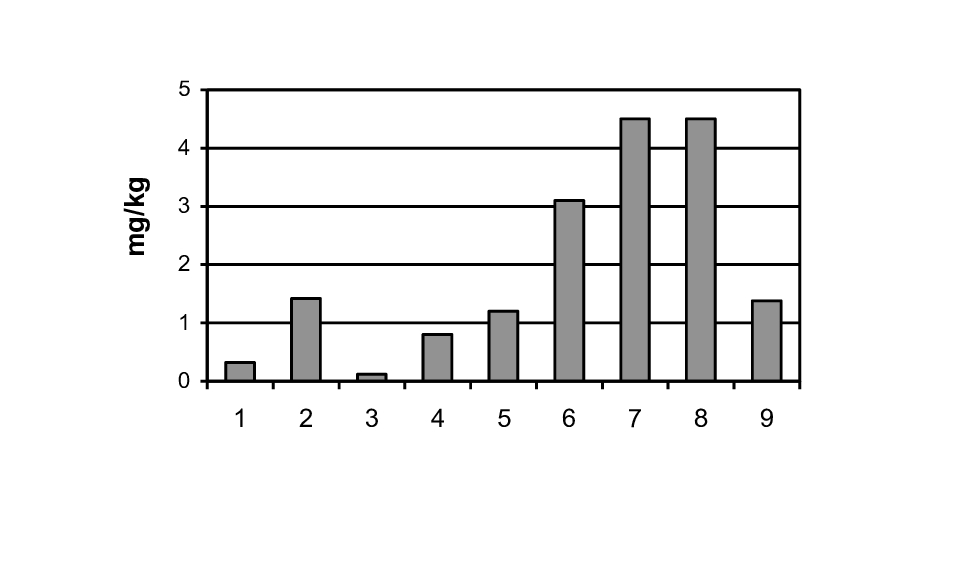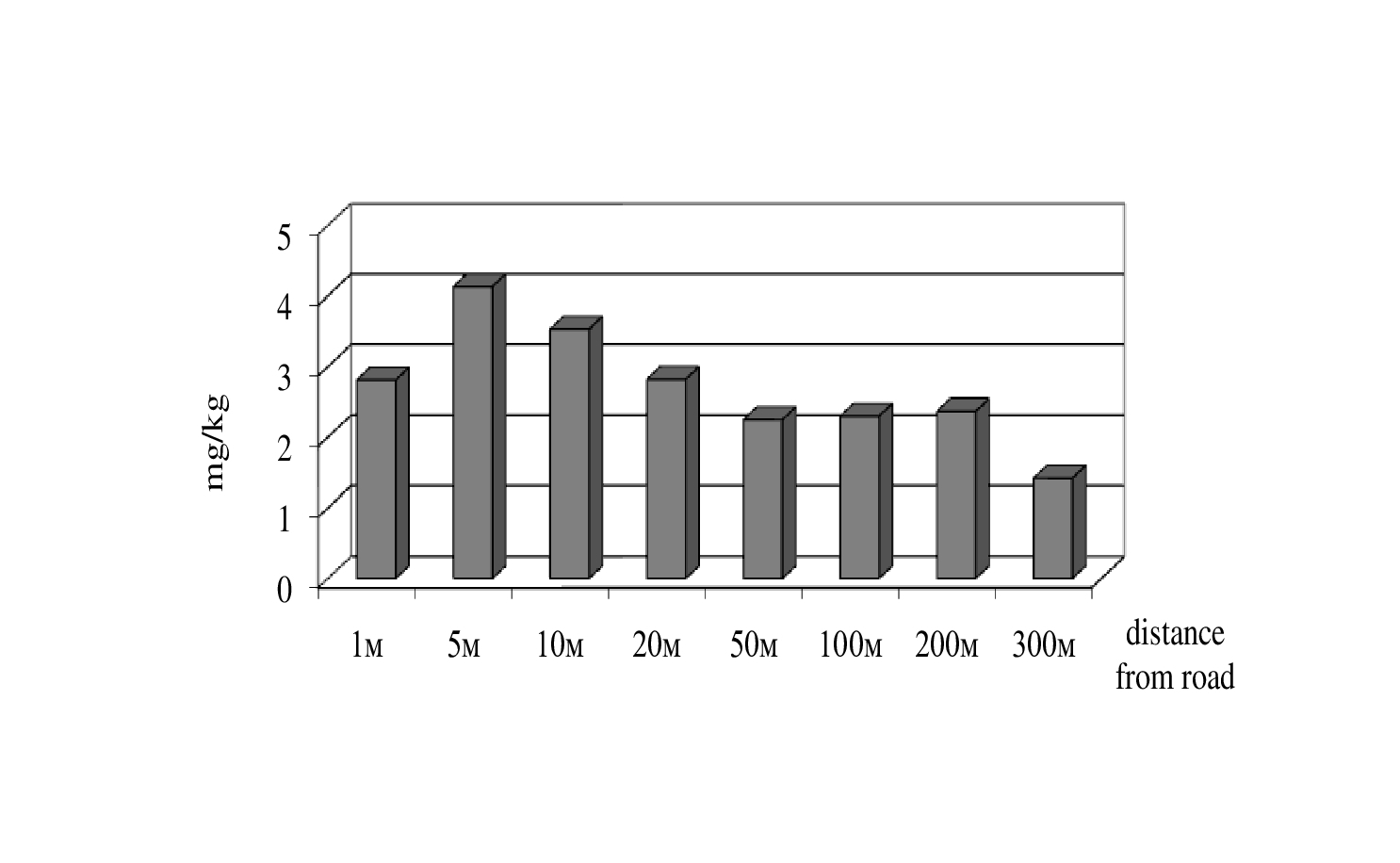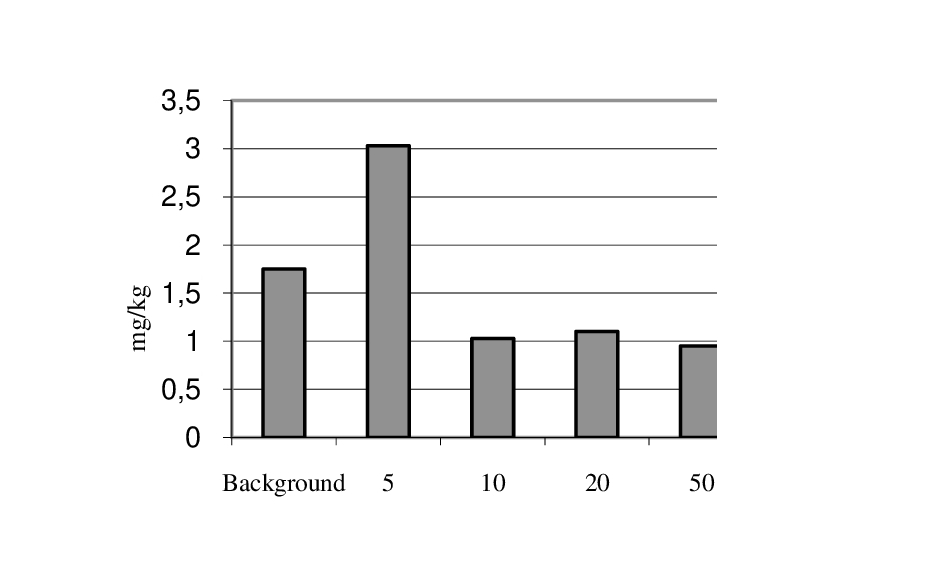Pb IN SOIL AND PLANTS OF EUROPEAN NORTH-EAST OF RUSSIA
Pb IN SOIL AND PLANTS OF EUROPEAN NORTH-EAST OF RUSSIA
Abstract
The results of the study of lead content in soils and plants of background and polluted territories of the North-East of the European part of Russia are presented. Lead content in soils and plants was studied from 1994 to 2021. It is shown that background territories have low content of pollutant in these natural objects. Pollution in this territory has a local character, being present in industrial zones, around cities, highways. The most vulnerable to the impact of pollution are territories of accumulative landscapes, including floodplains. Maximum concentrations of metals, often exceeding MPC, are marked in the phytomass of plants of all studied species collected in the immediate vicinity of highways at a distance of 1-20 m from the roadbed.
1. Introduction
Lead is among the most dangerous pollutants of atmospheric air, soil, water, vegetation, and further – animals and humans, it also is a common component of emissions from many enterprises of various industries and transportation. However, there is no complete picture of the spread of the pollutant over the territory of Russia. The background content of lead in soils and plants is significantly influenced by specific geochemical features of certain areas. In the North-East of the European part of Russia these studies are scattered, and therefore we are lacking a comprehensive approach to the problem. According to N.A. Burkov , the volume of anthropogenic lead intake into the environment of Kirov region reaches 451.64 tons/year. The sources of input are known, but migration processes of the element are insufficiently studied and are thus unpredictable. Control over the accumulation of the metal in the environment is complicated by the lack of well-developed and tested norms of its maximum permissible concentrations in both soils and plants. Significant differences in natural conditions of different regions do not allow using uniform scales of pollution degree. In this situation, the main criterion of comparison should be background concentrations of the element in soils and plants in the studied area.
2. Research methods and principles
Lead content in soils and plants was studied from 1994 to 2021 in background and technogenically polluted areas of the North-East of European Russia (Kirov region and Komi Republic). Background territories were considered to be those distant from roads, settlements and industrial zones by at least 3-5 km. The territories around cities, settlements, industrial enterprises, near highways were considered polluted. The main types of soils in the region (podzolic, sod-podzolic, gray forest, alluvial) and wild plants distributed in the area were studied. Collection of plant samples was accompanied by description of soil transects and soil sampling by horizons to a depth of 150 cm. Lead content was determined in the average sample made up of six repetitions. Seasonal dynamics of the content of mobile lead compounds in soils was studied from 1998 to 2021 at key sites in different natural-climatic zones of the region under forest, meadow and agricultural vegetation. Sampling was carried out 3-5 times during the vegetation period, with 3-8-fold repetition from 3 upper soil horizons. Mobile lead compounds were extracted from the soil with acetate-ammonium buffer solution with pH 4.8. Gross and mobile lead was determined by atomic absorption spectrophotometry on "Spectr-5-3". Description of soils and phytocenoses, collection of soil and plant samples, their chemical analysis were carried out according to standard methods . Statistical processing of the obtained results was carried out using STATGRAPHICS software.
3. Results and discussion
Gross lead content in the background soils of the surveyed region is relevant to the clark level and content in soils of the Russian Plain – 2.6 to 43.0 mg/kg. The arable horizons of loamy agricultural soils contain 26-37 mg/kg of Pb. Accumulation of gross lead in the upper horizons is observed, obviously in connection with organic matter as mentioned in other studies , . It may also be related to anthropogenic Pb input, which has recently became global. The distribution of gross lead in soil profiles is characterized as eluvial-illuvial.
The share of mobile Pb compounds in the gross content is maximum in the humus-accumulative part of the profile, especially in virgin soils (4-23%), and decreases with depth. Organogenic horizons of the background soils of the region contain insignificant amount of mobile lead (Table 1).
Table 1 - Content of mobile compounds of microelements in organogenic soil horizons
Forest sod-podzolic soils, mg/kg dry weight | Arable land sod-podzolic soils, mg/kg dry weight | Meadow sod-podzolic soils, mg/kg dry weight | Gray forest soils, mg/kg dry weight | Alluvial soils, mg/kg dry weight | |
Average value | 0.98±0.07 | 2.04±0.16 | 1.67±0.34 | 1.56±0.18 | 1.16±0.15 |
Variation | 0.20-3.18 | 0.75-5.80 | 0.45-4.02 | 0.42-4.02 | 0.11-3.20 |
The content of mobile lead compounds is elevated in arable soils, which is probably related to anthropogenic Pb intake during agricultural use.
The lead content in plants growing in uncontaminated areas is 0.05-3.0 mg/kg of dry weight and 2.7-94.0 mg/kg ash according to different publications in 1970-1980
. Background levels of lead content in forage plants are on average 2.1 mg/kg for grasses and 2.5 mg/kg dry weight for clover.In the North-East of European Russia the lowest background lead content is observed for forest woody plants (1.20 mg/kg), the highest – for meadow plants (2.70 mg/kg) (Table 2). The average concentration of lead in plants of uncontaminated habitats is 2.09 mg/kg. These figures are close to data from other regions.
Table 2 - Average concentration of lead in above group phytomass of plants of different ecological groups from uncontaminated habitats
Ecological group of plants | Pb, mg/kg dry weight |
Weeds | 2.49 |
Meadow plants | 2.70 |
Forest herbaceous plants | 2.27 |
Forest woody plants | 1.20 |
Cultivated plants (grains) | 1.78 |
All groups of plants from uncontaminated habitats | 2.09 |
Recently, lead has attracted much attention as one of the main components of chemical pollution. According to the degree of toxic effect on the environment, lead belongs to the most dangerous pollutants .
Therefore, control of lead intake and accumulation in natural objects is extremely important. However, the maximum permissible concentrations (MPC) of lead used in this process vary significantly between countries and often do not take into account the specific geochemical conditions of the area. In this complex situation, in our opinion, it is regional background concentrations of heavy metals (HM), especially their mobile forms that can act as a comparison criterion. Mobile forms of HMs and lead in particular are the most dangerous, as they are characterized by high biochemical activity and are intensively accumulated in organic matter.
In the north-east of European Russia heavy metal pollution is not continuous, but localized mainly around large cities, settlements and railway stations. This is all the more dangerous because the majority of the population lives in these areas and significant part of agricultural production is being manufactures there as well. The soil cover around the industrial zone of Kirov is contaminated with lead. The content of the element is higher than background level for sod-podzolic soils, and in some cases it is higher than MPC (Table 3)
Table 3 - Concentration of mobile lead compounds in soils of industrial areas
Area | Average Pb concentration (variation), mg/kg dry weight |
Territory of non-ferrous metal processing plant | 2.22 (1.0-6.6) |
Territory of municipal wastewater treatment plants | 1.24 (0.26-2.1) |
Background territories | 1.86 |
Maximum permitted concentration | 6.0 |
The most vulnerable to the impact of pollution are territories of accumulative landscapes, including floodplains. Aquatic ecosystems are often at the beginning of trophic chains and are powerful regulators of water balance and climate of sometimes vast territories. Pollution of these areas with heavy metals can lead to not only a decrease in the biodiversity of the surrounding fauna and flora, but also after some time affect the ecological balance of the entire adjacent area.
The peculiarities of the water-air regime of soils and periodic introduction of new material during flood periods contribute to the accumulation of HMs in floodplains. Therefore, pollution of floodplain soils is inadmissible.
From the point of view of the impact of emissions of enterprises on the surrounding landscapes, soil profiles in the floodplains of rivers near cities and industrial zones are indicative (Table 4). The values of the element content are not only several times higher than the background values, but in some cases even higher than MPC. Lead can freely penetrate into groundwater and further into the river network.
Table 4 - Content of mobile Pb compounds in floodplain soils
Area | Depth, cm | Pb, mg/kg |
Background territory | 0-3 | 1.00 |
3-14 | 2.80 | |
14-25 | 1.82 | |
25-91 | 0.75 | |
91-113 | 1.25 | |
113-134 | 1.00 | |
Wastewaster facility area | 0-3 | 11.40 |
3-11 | 3.10 | |
11-28 | 3.00 | |
28-59 | 1.70 | |
Сombined heat and power plant | 0-15 | 4,50 |
15-30 | 1,20 | |
Industrial zone | 0-4 | 4,4 |
4-25 | 4,5 | |
25-33 | 4,0 | |
33-92 | 3,7 | |
92-120 | 3,2 |

Figure 1 - Content of mobile forms of Pb in humus horizons of floodplain soils
Note: 1, 2, 3, 4, 5 – background territories; 6, 7, 8, 9 – suburban territories
The toxic effect of Pb on plants is mainly associated with the disruption of fundamental biological processes such as photosynthesis, growth, etc. The MPC values of lead for plants lie in a rather wide range – from 0.5-1.2 mg/kg to 10.0-20.0 mg/kg. The normal content of lead in aboveground organs of grasses is, according to researchers, from 1.5 mg/kg to 40.0 mg/kg dry weight.
To study the changes in the elemental composition of plants under the influence of anthropogenic pollution, plant samples were taken at the same anthropogenic locations as soils. The study did not reveal any reliable differences in the lead content in phytomass of plants from background and technogenic habitats. Probably, the magnitude of lead accumulation is determined by the species specificity of certain plants. The content of lead even within one plant species varies significantly. The values of pollutant concentrations in the phytomass of plants of technogenic territories varied in a very wide range, changing by 1-2 orders within one species. Concentrations of heavy metals in plants of one species of background habitats usually varied not more than 2-3 times. Most of the studied plant species reliably accumulate lead in their phytomass in polluted habitats (Table 5).
Table 5 - Pb content in plants from background and polluted areas
Species | Background territories | Polluted territories |
Vaccinium vitis-idaea L., shoots | 1.29±0.07* | 2.36±0.27 |
0.20-4.01** | 1.05-6.15 | |
Arctostaphylos uva-ursi (L.) Spreng., shoots | 1.59±0.17 | 1.73±0.41 |
0.21-4.00 | 0.20-6.10 | |
Hypericum maculatum Crantz, shoots | 1.12±0.23 | 2.28±0.25 |
0.33-2.50 | 0.27-7.00 | |
Trifolium pratense L., shoots | 1.98±0.16 | 1.43±0.36 |
0.50-3.21 | 0.20-4.00 | |
Convallaria majalis L., leaves | 1.70±0.21 | 3.03±0.21 |
0.04-6.00 | 0.90-6.10 | |
Tussilago farfara L., leaves | 1.50±0.33 | 3.38±0.45 |
0.50-4.43 | 0.66-9.24 | |
Rubus idaea L., shoots | 1.17±0.17 | 1.15±0.19 |
0.45-2.20 | 0.50-2.50 | |
Valeriana officinalis L. s.l., rootstock | 1.12±0.23 | 2.28±0.25 |
0.33-2.50 | 0.27-7.00 |
Note: * - average; ** - variation
Motor transport is a significant component of anthropogenic pressure on the environment. Motor transport emissions take up to 50% in the total amount of harmful emissions, and in some cases even exceed the amount of emissions from industrial enterprises
.Based on the results of our studies, for lead there is a reliable increase in the content of mobile compounds in the soil when approaching the roadway, although no significant excess of the element content over background values and MPC was found in the samples. Probably, low acidity of soils near roads promotes Pb binding in a fixed form. The values of lead content differ significantly along different routes, which is caused by traffic intensity, as well as by a complex combination of different soil characteristics (pH, humus content, moisture content, granulometric composition, etc.).
The chemical composition of plants of roadside phytocenoses significantly differs from background ones by increased Pb content
, .For example, in the shoots of forest plants (Arctostaphylos uva-ursi, Convallaria majalis) growing at a distance of 1-10 m from the highway; lead concentration increases more than twice, significantly exceeding the MPC (Fig. 2, 3).

Figure 2 - Pb content in Convallaria majalis shoots depending on the distance from the road

Figure 3 - Pb content in Arctostaphylos uva-ursi shoots depending on the distance from the road
Tanacetum vulgare L., Achillea millefolium, Tussilago farfara L., Plantago major L., Valeriana officinalis L. s.l., Sorbus aucuparia fruits accumulate lead in the roadside strip.
Maximum concentrations of metals, often exceeding MPC, are marked in the phytomass collected in the immediate vicinity of highways at a distance of 1-20 m from the roadbed. At a distance of 50-200 m from the roadway, the content of metals in different species becomes almost equal and gradually decreases. Pb content in phytomass in the 200-meter zone along the roads sometimes exceeds MPC, although in the main mass only exceeding the background values is observed. At a distance of 300-400 m from the roadway, the metal content becomes constant, close to the average content in background habitats.
As a result of the analysis of HM concentrations in plants of anthropogenic habitats, 38 plant species were identified that accumulate pollutants in the greatest amounts in anthropogenic habitats of the North-East of the European part of Russia. Among them 9 plant species actively accumulate lead – Rubus saxatilis L., Scirpus lacustris L., Tanacetum vulgare L., and 6 species of gen. Salix: S. caprea L., vimilalis L., S. triandra L., S. pentadra L., S. starkeana Willd., and S. phylicifolia L..
The identified plant species of technogenic habitats – accumulators of pollutants – can be used in phytomelioration and sanitation of polluted areas
.At this stage of research, no reliable dependence of lead content in plants and its concentration in soil and the amount of lead intake into the environment has been revealed. One of the reasons preventing the establishment of this dependence is the presence of significant temporal dynamics of the content of mobile lead compounds in soils and plants, which requires the development of new approaches to solving the problem. For example, in the soils of key sites, significant dynamics of the content of mobile lead compounds during the growing season was noted (Fig. 4).

Figure 4 - Seasonal dynamics of mobile Pb compounds content
4. Conclusion
Thus, the main part of the territory of the north-east of European Russia is characterized by relatively low content of mobile HM in soils and their accumulation in plants. The territories adjacent to large cities, industrial facilities and highways pose the greatest danger from the point of view of soil and plant contamination with HMs. Agricultural production, as well as collection of berries and medicinal plants in such areas, poses a real threat to public health.
